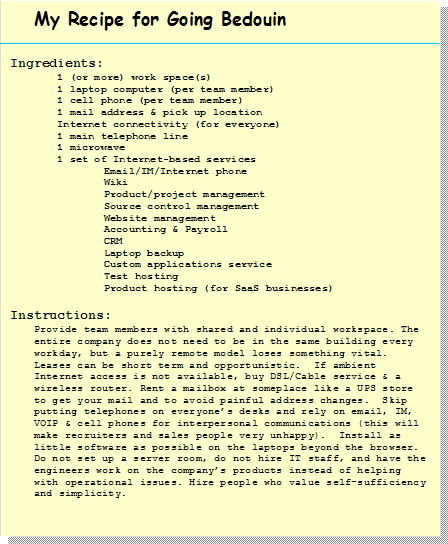Bootstrapping startups now often start with global teams, where even a small core team of three or four may span a half dozen time zones and someone is always awake.
Bootstrapping Startups: Bedouin, Global, Incessant, and Transparent
It’s now a norm that a bootstrapped start-up with only three or four members may still span a half dozen time zones. Jonathan Hallet wrote about “The Long Hallway” in April of 2007 and observed:
On the surface, the long hallway of the virtual company shares characteristics with the well-established practice of telecommuting. Employees use tools like Skype and other VOIP services for telephone calls and phone conferences, instant messaging to keep in touch, wikis to preserve group knowledge and processes, and web-based project management apps to organize and direct workflow.
However, there is a fundamental difference between telecommuting and the long hallway. To be a remote worker means that the core function of a company lies elsewhere. Telecommuters work remotely for businesses that already possess an established culture and physical buildings. They are satellites orbiting a larger concern. For virtual companies with long hallways, the company exists wherever its people are—and nowhere else.
Jonathan Hallet in “The Long Hallway“
A year earlier in February of 2006 Greg Olsen wrote about “Going Bedouin” (also in Web Work Daily Archive)
A technology startup begins in a state of simplicity and focus – some ideas, a few people and little else to get in the way. As the business grows, however, sources of complexity and distraction seem to appear from every direction.
The source I found most surprising, (when I last helped start a software business back in ’96), was the operational overhead that came with setting up an office, which continued to grow as we got larger. Before we knew it we were dealing with real estate leases, leased-lines, routers, VPNs, servers, workstations, firewalls, DMZ’s, UPS’s, telephone systems, voicemail systems, email systems, web servers & website management software, accounting software, sales & marketing software, software development software, groupware, IT support staff, attorneys, and many other things – none of which were directly related to our core business. The VP of Marketing “had to” spend numerous hours looking at color swatches to select the “right” furniture. While still a small company, an office move (within the same building) required weeks of planning, dedicated staff, and days to complete.
I remember longing wistfully for the days when the company’s infrastructure fit into my backpack.
Greg Olsen wrote about “Going Bedouin”
Olsen’s answer was to move all but the minimal endpoints of infrastructure, cellphone and laptop, into the cloud. As Parkinson observed “Perfection of planned layout is achieved only by institutions on the point of collapse.” Better to keep things agile, easily re-configured, and evolving in response to new customer needs.
One advantage of working around the globe in a cloud infrastructure is that incessant work on a project doesn’t require anyone to lose sleep. Product development and support can “follow the sun,” whether it’s direct employees or partners with clear service level agreements. They can all access the same infrastructure, picking up where others left off and check-pointing work for a circular relay race around the globe.
What’s interesting is that the price points on service-based infrastructure such as blogs, wikis, skype and other VoIP teleconferencing, build automation and management tools, common calendars, and simple task and workflow management make them available for on the order of $100/employee per month. This takes an enormous amount of friction out of key processes like product development, support, and management.
Related Blog Posts
- Going Bedouin / Co-Working Becoming the Default
- SKMurphy blog: “Beat the Clock“


Pingback: SKMurphy, Inc. » Tools for Finding a Physical Workspace: Deskwanted, LiquidSpace, Loosecubes, OpenDesks